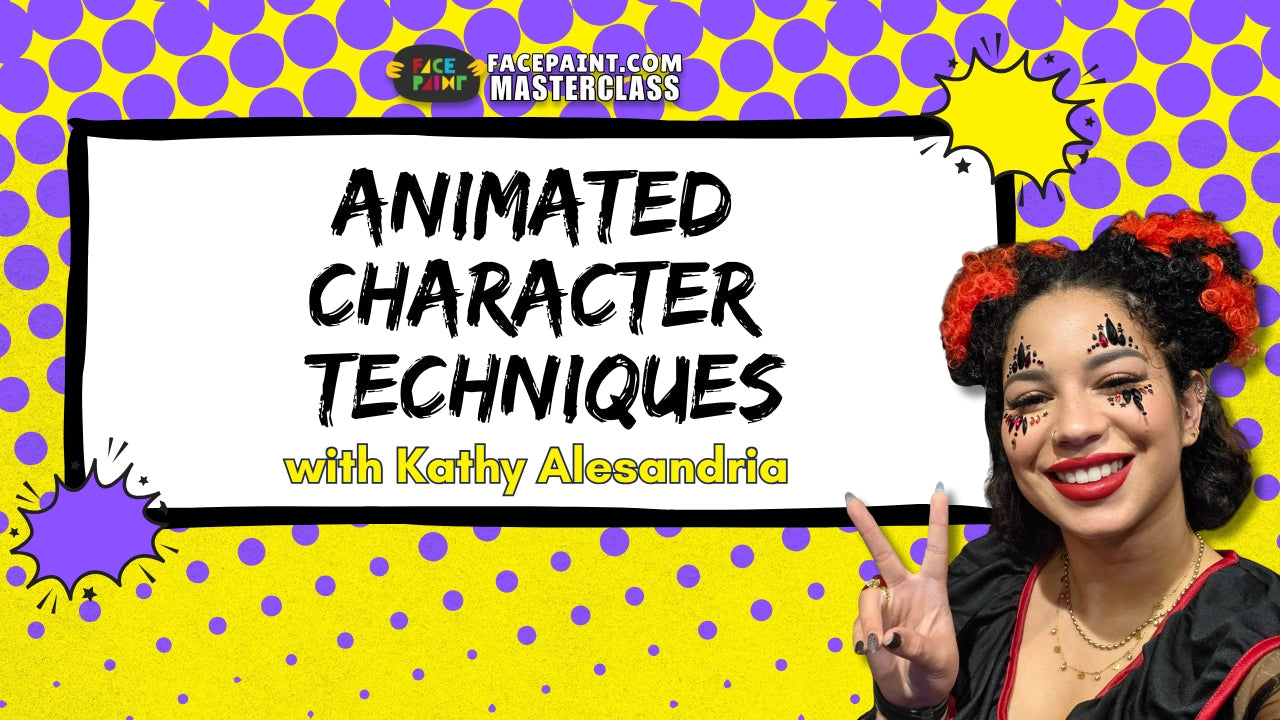
Face painting is fun, but it can also be a little confusing when you’re new to it. In this post we’ll talk about the basics of face painting so you can start painting faces with confidence! This is a brief overview of what you’ll need to know to get started. Be sure to click on the links provided to get more in-depth information on these topics.

#1. How to Choose the Right Face Painting Brushes

Finding the right brush can make all the difference when you’re face painting. When I found a good quality round brush for example, my teardrops suddenly improved.
Here’s a brief description of the types of brushes you will likely be using as a face painter. All brushes come in a variety of sizes. Use smaller brushes for fine details and bigger brushes to cover larger areas quickly.
Round Brushes
The round brush, a staple in any face painter's kit, is used for making teardrops, outlines, highlights, and more. If I could only choose one brush to paint with it would be this one. To reshape a tip, simply drag and roll a wet brush along a towel and lay flat to dry.
Flat brushes are great for making thick, bold lines or filling in large areas quickly. You can also use them for one-stroke designs.
Angle Brushes
Angle brushes can be used to create gorgeous one-stroke flowers. They are also great for lining the eyes or filling brows.
Petal and Flower Brushes
If you’re into creating floral face painting designs, you simply must have a petal brush. As soon as you start creating flowers with a petal brush you’ll see the difference between these shorter bristled brushes and your typical round brush. Filbert brushes have a rounded tip and are commonly used to make leaves, but there are other ways to use them. For example, large teardrops and feathers can be made with a filbert brush.
Foam Tip Brushes
Foam tip brushes are used for applying powdered makeup and glitter. The Paradise Smoothie blender is a type of foam tip brush that is made to be used with Mehron Starblend.
Fan Brushes
Use a fan brush to create butterfly wings, feathered edges on clouds, flowers and more. With a little practice and your imagination, you’ll be sure to find lots of other uses for this brush.
For more details on this topic, click here.
#2 How to Make Simple Teardrops

Great-looking teardrops will distinguish you from the amateurs. Here are some tips for making perfect teardrops every time. Be prepared to practice over and over until you get them right!
Load a round brush with the color of your choice. As you are loading your brush, twist the bristles and pull them across the pan to create a nice pointy tip.
Press the round brush onto the skin and then drag the tip across the skin as you gradually pull up on the brush.
As a general rule, the points of your cluster of teardrops should all point towards the same spot.
Practice this technique by making a dot on your arm. Begin making a series of teardrops that all point towards the dot. Vary the length of the teardrops to create a pleasing design.
For more advice on the art of teardrops, check out this detailed post and be sure to watch this helpful video too!
#3. How to Make Swirls

Once you can make great-looking teardrops, it’s time to move on to swirls. These are basically just elongated teardrops that curve.
Use the same technique as you did to make teardrops. Press down and lift up as you drag your round brush in a spiral motion. Your lines should be getting thinner towards the tip of the swirl.
You can create an entire eye design just using teardrops and swirls!
#4. How to Blend With Sponges
Lightly spritz a sponge with water and pick up color by rubbing it back and forth across the face paint. Pat the color onto skin until you get the desired coverage. If the face paint is not transferring to the skin easily, you may need to spritz more water on your sponge. If the face paint drips, then you’ve used too much water. In that case, pat off excess water from the sponge on a towel.

Pick up the second color and apply next to the first color. Gently pat the second color into the first color until the line between the two colors blurs. If the color is not blending well enough, use the clean back of the sponge to blend the two colors together. Add other colors as desired.

Tip: When blending, it’s easier to start with the lightest color first.
#5. How to Enhance a Basic Design
The difference between a ho-hum face paint design and one that wows is all in the details. Take the following tips from Beth MacKinney who enhanced a superhero mask seen below.

After painting solid shapes, load a sponge with a contrasting face paint color and apply over the design.

Next, create an outline and eyebrows with black face paint and a small round brush. Last, using a good opaque white face paint, like Diamond FX white, add highlights to a few spots.

Notice the difference between the first and last photos? Painting the details on a design like this will take about two minutes, and makes a world of difference.
For more details on this design click here.
#6. How to Clean You Face Painting Brushes

While you are face painting, always have clean water on hand for rinsing your brushes in between faces. Many face painters use two cups filled with water so that they can rinse brushes twice.
Products like Brush Bath and BeautySoClean Wipeout can help to keep your brushes clean while you’re face painting.
When it comes to soap to wash your brushes, you can use a mild organic castile soap, or a soap especially formulated for wash face paint brushes like The Face Painting Shop Blue Brush Soap or Cameleon Brush & Body Lemon Sorbet Foam.
I can’t live without a brush cleansing pad to get all the face paint out of my brushes.
You should also disinfect your brushes between jobs using isopropyl alcohol or a professional disinfecting makeup brush cleaner (I love Parian Spirit).
Watch this video for more details on how to clean your brushes.
#7. How to Clean Face Painting Sponges

Place dirty sponges in a clean bowl filled with warm water. Add a few drops of mild liquid soap and squeeze out the face paint from the sponges. Place sponges in a second clean bowl of water and repeat.
I put clean, wet sponges in the microwave for 2 minutes to kill bacteria. Be careful to let them cool off before placing them in a clean mesh bag. Hang the bag and allow sponges to dry completely before storing.
#8. How to Get Glitter to Stick

Glitter makes everything better, but sometimes it just doesn’t stick. If the face paint is dry by the time you get to spritzing on glitter, then it won’t stick.
I rarely apply glitter as the last step. Instead, I add glitter as I go when the face paint is wet. So if I start creating a princess crown by painting on some one-stroke loops, I stop and spray the face painting glitter before I move on to adding teardrops and swirls.
As a last resort, you can, very carefully,use a spray bottle to spritz water onto the design. This will dampen the face paint enough so that the glitter will adhere. But use caution. Too much water and you’ll have a dripping mess on your hands. Practice on your arm a few times to get the feel for how much water to spritz before you try this on a customer.
Another option is glitter creme. Glitter creme has a waxy consistency like lip balm and can be applied right over dry face paint.
#9. How to Use a Face Painting Stencil

Stencils are a fun way to add impressive detail to your face painting designs. But I don’t think there’s a face painter out there who hasn’t had a frustrating experience with them.
Here are some tips for using stencils successfully.
- Make sure the base layer that you are stenciling over is completely dry before you stencil. I repeat, completely dry!
- You can stencil with any color, but I find that white is the safest bet for patterns that pop.
- Dab your loaded sponge on your wrist to make sure there’s not too much water before applying through a stencil. Too much water on your sponge will create a mess.
- Try rubbing the sponge back and forth over the stencil instead of just patting.
#10. How To Remove Face Paint and Staining
Water-based face paint can be removed with soap and water. It is advised, not to use water alone, as that may result in light staining.
I often recommend parents use an oil-based makeup remover to get rid of stains left behind after washing. Face painter Marina Krmek recommends using micellar water to remove stains.
Marina also applies a barrier spray like Mehron Barrier Spray to skin before applying face paint to prevent staining.
To read more details about preventing and removing face painting stains, read this post.
While you’re face painting, you can use baby wipes to clean up any smudges or mistakes.
Alcohol based face paints, like ProAiir can be removed with an oil based makeup remover, alcohol or liquid soap (with some scrubbing).
If you choose to use gems, make sure you know how to remove the adhesive. There are self-adhesive gems that you just simply peel and stick. Or you can add a cosmetic glue to the back of a gem and adhere that way. To remove adhesives, be sure to read the manufacturer’s instructions. Some require a special type of remover and others come off with soap and water.
Here's a helpful video about how to remove face paint.
I hope these tips help you to get a great start! Have you learned any face painting tricks? Please do share in the comments sections. It’s always great to hear from you.
Vanessa Tsumura is a face painter and writer in Milwaukee, Wisconsin.
 FREE SHIPPING FOR USA ORDERS OVER $100
FREE SHIPPING FOR USA ORDERS OVER $100








Leave a comment (all fields required)